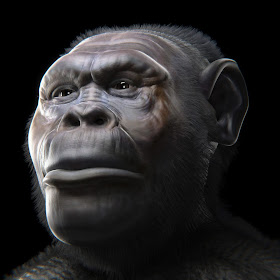One of the main attractions of the open source exhibition "Facce. I molti volti della storia umana"[1] is the facial reconstruction of four of the five individuals found in the Dmanisi (Georgia) excavation [2] and currently known as Homo georgicus. This project was possible thanks to the kindness of Prof. David Lordkipanidze (of the Georgian National Museum) and to the precious help of our friend Dr. Zviad Sherazadishvili.
The particular feature that characterized the facial reconstructions of the specimens of H. gerogicus is that each skull has some peculiarities that make it unique compared to the other subjects of the same species so far recognized. Moreover these differences are due both to sex, both to age and both to individual physiognomy. Indeed the five skulls of Dmanisi represent a wide range of variables, with at least a female specimen, two males with different individual characteristics (one with a pronounced undershot), an old subject and a young one (unfortunately impossible to reconstruct due to the missing facial part of the cranium).
The forensic reconstruction, performed with the anatomical deformation methodology [3], amplifies these differences, giving a face to our ancestors and simplifying at the same time the perception of the peculiarities which characterize the four specimens, at least for those people who are not familiar with anthropology and osteometry (like most of the visitors of the exposition).
According to the main purpose of the open source exhibition (sharing as open data all the material we produced), today I am uploading the result of these reconstructions on Wikimedia Commons with a CC-BY license. Here below you can see the four images developed, like always, with a team work. This time the equipe was composed by Nicola Carrara (Anthropological Museum of the University of Padua) and Luca Bezzi (Arc-Team), for the 3D scan with SfM and MVSR techniques [4]; Cícero Moraes (Arc-Team), for the facial reconstruction with Blender; Telmo Pievani for the final validation (University of Padua, Biology Department).
 | |
| The first male subject |
 |
| The old subject |
 |
| The female subject |
 |
| The second male subject (with pronounced undershot) |
Webography
[1] FaceBook, ATOR 1, 2, 3, 4, 5
[2] ATOR 1
[3] ATOR 1, 2
[4] ATOR 1, 2, 3, 4, 5, 6, 7, 8, 9, 10, 11, 12, 13, 14, 15, 16, 17, 18, 19
No comments:
Post a Comment